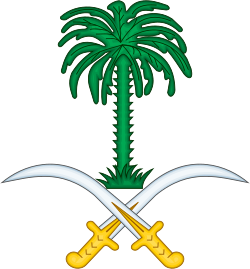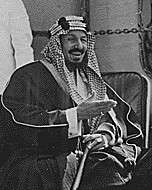Abdul-Rahman bin Abdulaziz
Abdul-Rahman bin Abdulaziz (Arabic: عبد الرحمن بن عبد العزيز آل سعود, ʿAbd ar-Raḥman ibn ʿAbd l-ʿAzīz Āl Saʿūd; 1931 – 13 July 2017) was a senior member of the House of Saud and Saudi Arabian deputy minister of defense and aviation.
| Abdul-Rahman bin Abdulaziz | |||||
|---|---|---|---|---|---|
| Deputy Minister of Defense and Aviation | |||||
| In office | 1978 – 5 November 2011 | ||||
| Predecessor | Turki II bin Abdulaziz Al Saud | ||||
| Successor | Khalid bin Sultan | ||||
| Monarch | |||||
| Born | 1931 Kingdom of Nejd and Hejaz | ||||
| Died | 13 July 2017 (aged 85–86) | ||||
| Spouse | Maha Al Ibrahim | ||||
| |||||
| House | House of Saud | ||||
| Father | Ibn Saud | ||||
| Mother | Hassa bint Ahmed Al Sudairi | ||||
Early life and education
Abdul-Rahman was born in 1931 as the sixteenth son to Ibn Saud and third son to Hassa Al Sudairi.[1] At the time of his death, he was the oldest living member of the Sudairi Seven.[2][3] Abdul-Rahman, the first of Ibn Saud's sons to study in the West,[4] received a bachelor of arts degree from the University of California, Berkeley, and graduated from the California Military Academy.[5]
Career
He was the counsellor for royal family affairs during the mid-1970s.[6] Abdul-Rahman replaced his brother, Prince Turki II, as the kingdom's deputy minister of defense and aviation in 1978 when Turki resigned;[7] before that, he was a businessman.[8] He held the post until 5 November 2011.[7] During the 1980s, when he was deputy minister, Abdul-Rahman reportedly provided food service to the ministry with his own company.[9]
During Prince Sultan’s absence from the Kingdom for medical treatment, he increased his activity at the ministry. Abdul-Rahman was often described as becoming more irritable with age.[2]
He was relieved from his post as deputy minister on 5 November 2011. According to Al-Quds Al-Arabi, Abdul-Rahman was dismissed by King Abdullah when, unhappy at being bypassed as crown prince in favor of Prince Nayef, he refused to declare allegiance to Nayef.[10][11]
Succession
The prince was reportedly the only son of Ibn Saud to oppose the 2007 formation of the Allegiance Council, despite support from nearly all sons of the king. The apparent reason for his protests was the fact that he was next in age, after Crown Prince Sultan; the new succession arrangement is based on merit, rather than age. Prince Salman, his younger brother and the referee in family disputes, reportedly met with Abdul-Rahman and told him to "shut up and get back to work".[12]
Personal life
He was married to Maha Al Ibrahim, sister of King Fahd's wife Al Jawhara Al Ibrahim and Al Ibrahim's brothers (including Waleed Al Ibrahim).[13] Abdul-Rahman's son-in-law is Nayef bin Sultan bin Fawwaz al-Shaalan.[14] One of Abdul-Rahman's son, Mohammed, is the deputy governor of Riyadh.[15]
Ancestry
| Ancestors of Abdul-Rahman bin Abdulaziz | |||||||||||||||||||||||||||||||||||||||||||||||||||||||||||||||||||||||||||||||||||||||||||||||||||||||||||||||||||||||||||||||||||||||||||||||||||||||||||||||||||||||||||||||||||||||||||||||||||||||||||||||||||||||||||||||||||||||||||||||||||||||||||||||||||||||||||||||||||||||||||||||||||||||||||||||||||||||||||||||||||||||||||||||||||||||||||||||||||||||||||||||||||||||||||||||||||||||||||||||||||||||||||||||||||||||||||||||||||||||||||||||||||||||||||||||||||||||||||||||||||||||||||||||||||||||||||||||||||||||||||||||||||||||||||||
|---|---|---|---|---|---|---|---|---|---|---|---|---|---|---|---|---|---|---|---|---|---|---|---|---|---|---|---|---|---|---|---|---|---|---|---|---|---|---|---|---|---|---|---|---|---|---|---|---|---|---|---|---|---|---|---|---|---|---|---|---|---|---|---|---|---|---|---|---|---|---|---|---|---|---|---|---|---|---|---|---|---|---|---|---|---|---|---|---|---|---|---|---|---|---|---|---|---|---|---|---|---|---|---|---|---|---|---|---|---|---|---|---|---|---|---|---|---|---|---|---|---|---|---|---|---|---|---|---|---|---|---|---|---|---|---|---|---|---|---|---|---|---|---|---|---|---|---|---|---|---|---|---|---|---|---|---|---|---|---|---|---|---|---|---|---|---|---|---|---|---|---|---|---|---|---|---|---|---|---|---|---|---|---|---|---|---|---|---|---|---|---|---|---|---|---|---|---|---|---|---|---|---|---|---|---|---|---|---|---|---|---|---|---|---|---|---|---|---|---|---|---|---|---|---|---|---|---|---|---|---|---|---|---|---|---|---|---|---|---|---|---|---|---|---|---|---|---|---|---|---|---|---|---|---|---|---|---|---|---|---|---|---|---|---|---|---|---|---|---|---|---|---|---|---|---|---|---|---|---|---|---|---|---|---|---|---|---|---|---|---|---|---|---|---|---|---|---|---|---|---|---|---|---|---|---|---|---|---|---|---|---|---|---|---|---|---|---|---|---|---|---|---|---|---|---|---|---|---|---|---|---|---|---|---|---|---|---|---|---|---|---|---|---|---|---|---|---|---|---|---|---|---|---|---|---|---|---|---|---|---|---|---|---|---|---|---|---|---|---|---|---|---|---|---|---|---|---|---|---|---|---|---|---|---|---|---|---|---|---|---|---|---|---|---|---|---|---|---|---|---|---|---|---|---|---|---|---|---|---|---|---|---|---|---|---|---|---|---|---|---|---|---|---|---|---|---|---|---|---|---|---|---|---|---|---|---|---|---|---|---|---|---|---|---|---|---|---|---|---|---|---|---|---|---|---|---|---|---|---|---|---|---|---|---|---|---|---|---|---|---|---|---|---|---|---|---|---|---|---|---|---|---|---|---|---|---|---|---|---|---|---|---|---|---|---|---|---|---|---|---|---|---|---|---|---|---|---|---|---|---|---|---|---|---|---|---|---|---|---|---|---|---|---|---|---|---|---|---|---|---|---|---|---|---|---|---|---|---|---|---|---|
| |||||||||||||||||||||||||||||||||||||||||||||||||||||||||||||||||||||||||||||||||||||||||||||||||||||||||||||||||||||||||||||||||||||||||||||||||||||||||||||||||||||||||||||||||||||||||||||||||||||||||||||||||||||||||||||||||||||||||||||||||||||||||||||||||||||||||||||||||||||||||||||||||||||||||||||||||||||||||||||||||||||||||||||||||||||||||||||||||||||||||||||||||||||||||||||||||||||||||||||||||||||||||||||||||||||||||||||||||||||||||||||||||||||||||||||||||||||||||||||||||||||||||||||||||||||||||||||||||||||||||||||||||||||||||||||
References
- Winberg Chai (22 September 2005). Saudi Arabia: A Modern Reader. University Press. p. 193. ISBN 978-0-88093-859-4.
- Nathaniel Kern; Matthew M. Reed (15 November 2011). "Change and succession in Saudi Arabia". Foreign Reports Bulletin. Retrieved 25 May 2012.
- "Saudi succession developments" (PDF). Foreign Reports Inc. 28 October 2011. Retrieved 25 April 2012.
- J. Kechichian (2 August 2001). Succession In Saudi Arabia. Springer. p. 179. ISBN 978-0-312-29962-0.
- Sabri, S. (2001). The house of Saud in commerce: A study of royal entrepreneurship in Saudi Arabia. I. S. Publications.
- Gulshan Dhanani (19 June 1982). "The King Is Dead, Long Live the King". Economic and Political Weekly. 17 (25). JSTOR 4371042.
- Nimrod Raphaeli (September 2003). "Saudi Arabia: A Brief Guide to its Politics and Problems" (PDF). MERIA. 7 (3): 11. Archived from the original (PDF) on 6 March 2012.
- William B. Quandt (1981). Saudi Arabia in the 1980s: Foreign Policy, Security, and Oil. Washington DC: The Brookings Institution. p. 79. ISBN 978-0-8157-2051-5.
- "The role of Saudi princes in uniform". Wikileaks. 27 May 1985. Archived from the original on 26 October 2011. Retrieved 25 May 2012.
- Ahmed Masri (7 November 2011). الامير عبد الرحمن اعفي من منصبه لرفضه 'البيعة' [Saudi Prince Abdul Rahman Reportedly Removed for Refusing to Pledge Allegiance]. Al Quds Al Arabi (in Arabic). Archived from the original on 10 November 2011. Retrieved 21 January 2012.
- Ian Bremmer (2 March 2012). "The next generation of Saudi royals is being groomed". Foreign Policy. Archived from the original on 21 May 2012. Retrieved 25 May 2012.
- "Crown Prince Sultan backs the king in family". Wikileaks. 12 February 2007. Retrieved 6 May 2012.
- "HH Princess Al Jawhara bint Ibrahim". King Abdulaziz University. 2010. Retrieved 14 May 2012.
- Ireland, Doug (6 May 2004). "Royal Coke". LA Weekly. Retrieved 17 March 2017.
- Karen Elliott House (June 2017). "Saudi Arabia in Transition: From Defense to Offense, But How to Score?" (Senior Fellow Paper). Belfer Center for Science and International Affairs. p. 5. Retrieved 2 June 2020.
- "عام / الديوان الملكي : وفاة صاحب السمو الملكي الأمير عبدالرحمن بن عبدالعزيز آل سعود". Saudi Press Agency (in Arabic). 13 July 2017. Retrieved 13 July 2017.
- Rajab, Alaa. "Wafat al'amir ebdalrhmn bin ebdaleaziz ean eumr yunahiz al86 eamana" وفاة الأمير عبدالرحمن بن عبدالعزيز عن عمر يناهز الـ86 عامًا [Prince Abdulrahman bin Abdul Aziz died at the age of 86 years]. Al-Wafd (in Arabic). Retrieved 13 July 2017.

